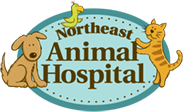Traveling With Your Dog Camping
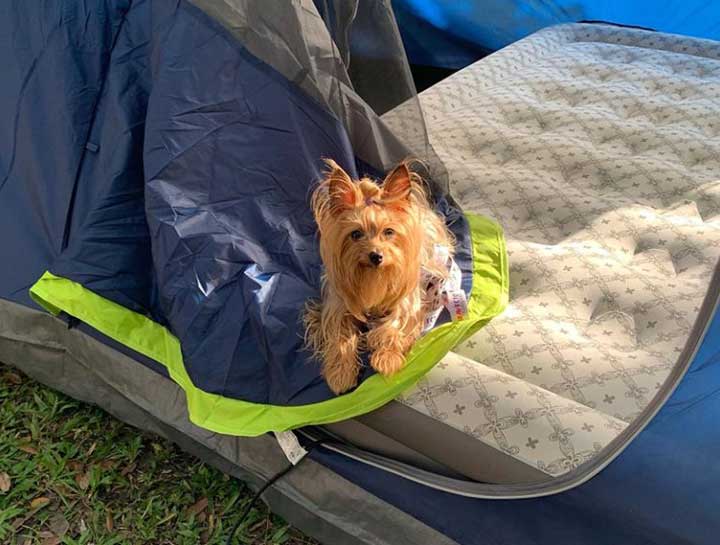
We hope you’re enjoying our “Traveling With Your Dog…” series about local places you can enjoy with your pet! A lot of things have changed in 2020, including the way we vacation. For a while, we weren’t able to vacation at all. Even now, with restrictions beginning to lift but news of possible new COVID strains developing, many are still hesitant to travel on a plane or stay in a hotel. More and more people are deciding that camping is a safe way to get away from it all, and socially distance themselves from others, all while being out in the fresh air.
Not All Campgrounds are Created Equal
In Florida, this time of year, with its cooler temperatures, is certainly a great time to camp. Plus, many campgrounds allow dogs, making it a true family vacation. What do you need to know before packing up the tent and heading out to the great outdoors with your pup?
While packing for your dog to accompany you on your trip may seem as straightforward as getting them ready to go on a walk—plus throwing in some food—a camping trip requires just a little more preparation. We will follow London as she goes on her first camping trip with her family, and see what it took to make sure she was a happy camper.
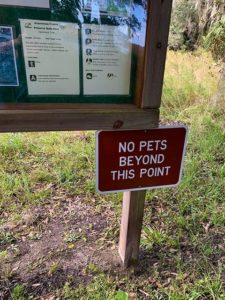
While there are plenty of campgrounds that allow pets,* not all campgrounds do—at least, not in all individual campsites. Ft. DeSoto, for example, allows pets only in their designated pet-friendly camping area. Other campgrounds that allow pets will not permit them on their primitive campsites. Even after you’ve found a campground or area where you would like to pitch your tent, each campground has different rules about bringing your dog along. For example, there are rules about what type and length of leash they must be on. So be sure to familiarize yourself with the campground rules ahead of time.
* While this article is written primarily for dog owners, many campgrounds allow cats and other types of pets. One of London’s friends, a Sphinx kitty, loves to camp with his family and will even walk on a leash!
Before You Take Your Dog Camping
Travel. London’s first camping trip was to Kissimmee Prairie Preserve State Park, which, despite what the name may first make you think, is nowhere near Orlando. Located in Okeechobee, the campground was just short of 3 hours away from St. Petersburg. If your dog isn’t great with car rides, your veterinarian can help with ways to minimize anxiety and car sickness.
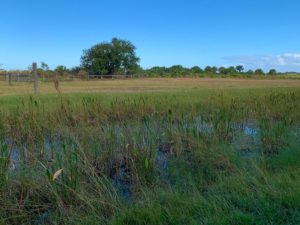
Central Florida’s Prairie Land!
Vaccinations. Most campgrounds require your pet to be vaccinated, so ensure that your dog is up-to-date on all vaccines. Some campground locations lack consistent cell/internet service, so if you normally access your pet’s records online, you may want to print out a paper copy or take a screenshot of your pet’s electronic record.
Parasite Preventatives. You’ll also want to make sure you’ve administered their monthly flea & tick, and heartworm preventative. London is on flea and heartworm prevention, but tick prevention was something I didn’t think of, and after a romp through a field, I found a tick crawling on my arm while holding London!
Microchip and Photo. If your dog isn’t already microchipped, now is a great time to do so. While wearing a license is required by law in many areas, tags can get lost or be removed. A microchip is your dog’s ticket home if they get lost. Be sure you have a current photo of your pet as well.
Hiking Trails. Before you leave home, take some time to research which trails you may want to walk, as some do not allow dogs. Trail maps can usually be found online. On some trails London was able to accompany us while on her six-foot leash, but there were others marked “No Dogs Allowed.” Take into consideration your dog’s age and fitness level when planning your hikes.
Accommodations. Some campgrounds, like the one we visited, have free self-service kennels you can leave your dog while you explore areas prohibited to pets. Our campground also lets you leave your dog unattended on a leash or in a crate at the campsite for up to 30 minutes at a time. The crate option would be helpful if you decide to camp alone with your pet, as dogs aren’t allowed inside the restroom/shower area.
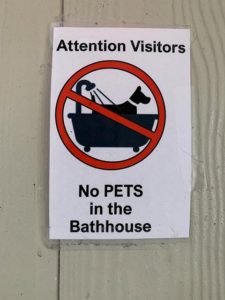
Emergencies. You will also want to research the area you’ll be staying in for the nearest local emergency vet, and familiarize yourself with how to get there, just in case the unexpected happens.
Is My Dog Camp Ready? Is My Dog Even the Camping Type?
Some dogs just aren’t “outdoorsy.” They go outside to do their business, but they cry right away to come back inside. Is your dog well-behaved when they see another dog? If your dog is hard to control physically or vocally when they see another dog stroll by, you may want to consider some obedience classes before your vacation, to help maintain proper camp etiquette.
Barking. All dogs bark and other campers no doubt expect to hear some noise, but excessive vocalization is a big no-no. Nothing saps the peace and calm of a camping trip faster than having to constantly ensure your dog stays quiet, especially during designated “quiet time” hours—usually anywhere from 10 or 11pm to 7am.
Nature Sounds. Sounds of birds, squirrels, raccoons, and even wild boar, can be new to dogs and elicit an alarm response. Being unable to follow the campsite’s behavior rules can result in expulsion. Remember, your tent is not only your home away from home, but other campers feel that way about their tent too. So you will want your pet to behave as you would at home, or someone else’s home. After all, some campsites are within feet of each other.
Commands. You will also want to brush up on commands like sit, stay, come, quiet, drop it, and leave it. “Leave it” is especially important, as you never know what curious things your dog may find, like mushrooms, snakes, frogs, and all manner of intriguing bugs.
So, you’ve researched your destination and your dog is up to the task and is fully vaccinated and protected from parasites. Is there anything else you can do to help prepare your dog for the adventures that await?
Camping Dry Run
If, before your trip, you decide to air out your tent, or do a pre-setup to make sure you have all the tent components, you can use this as an opportunity to get your dog excited about spending time in the tent. Even brand-new tents may arrive with missing pieces, so it’s always a good idea to make sure you will have a working tent when you arrive.
After you have the tent set up in your yard, get inside and call your dog to you. You can give them a few treats while inside the tent, and bring some of their favorite toys with you, so they can see that this is a fun place to be. You may even want to have a backyard campout so that they can get used to sleeping inside the tent if this is what you’ll be doing when you camp. If you’re not able to do a dry run with the tent before you go camping, use these same ideas as soon as you get the tent set up on your site.
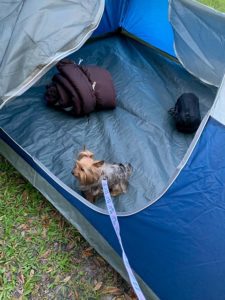
London exploring her home away from home
Some people bring a dog crate for their dog to sleep in, or to put their dog in while they are setting up camp or cooking. Now is the time to get your dog comfortable with being inside a crate, if they aren’t already.
We’ve Arrived! Now What?
Setting Up Camp. When we arrived with London at our campsite, it was just starting to get dark, so getting the tent set up was the number one priority. If you have time before dark, walking your dog around the site is a great idea. London was so excited to explore, and especially to go meet the dog “next door,” but instead she had to follow us around on her leash as we rushed to beat the clock, or in this case, the sunset.
London is little enough that she wasn’t pulling on my arm when I was trying to work. But if you have a larger dog, then a tether/stake for their leash, or the aforementioned crate, are great alternatives to trying to hold on to your dog’s leash while setting up camp.
Safety Checks. Check the area your dog will have access to while tethered to make sure there are no sticks or plants around that they can chew or that could potentially cause harm. Never leave them within reach of the campfire. Even if the fire has gone out, the coals and ash could still be hot and cause burns. Thankfully, the tent was a breeze to set up, so London was rewarded with meeting Scout, the gentle giant at the RV next to us, and then a walk around the site and dinner.
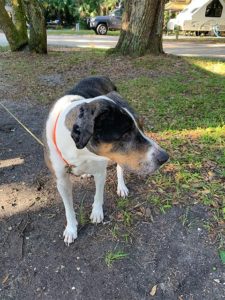
Our camping neighbor, Scout!
Night Excursions. The draw of Kissimmee Prairie Preserve State Park for us was that it’s one of the few places left in Florida with a “dark sky,” making it a destination for stargazers. When it got dark, we grabbed our red light flashlights (these types of flashlights are astronomer approved as they won’t interfere with your night vision) and walked to the telescope pad to talk with some of the folks that had set up their telescopes. They loved meeting London as much as she loved meeting them. She was our “in” to start the conversation!
Along the dirt road, we heard baby alligators chirping, but we wouldn’t realize until the next day just how close we were to them. Despite the cooler temperatures, mosquitoes were still a bit of an issue for a few hours (thanks Florida!), so I was glad London had taken her Trifexis.
London happily explored the dirt roadway, clearly being able to see far better than we could with our red flashlights. Having a reflective harness for her would have been helpful, as would having a red light clipped on it. We’ll be adding that to our list for next time.
We were glad to be able to walk all her energy out because back at camp we were ready for a fire. One thing about camping, it’s amazing how slowly time can seem to pass—in a good way! London was content to snuggle up in my lap by the fire.
Pet Pastimes. Even though a camping trip can be filled with a lifetime of new and interesting smells, a dog may still get bored, especially if you want to spend the evening unwinding by a campfire. So be sure to bring some toys along with you. Interactive puzzle toys that make your dog work for a treat can occupy large amounts of time.
Unexpected weather can cause you to need to take shelter from the rain in your tent, so something that will keep them happily entertained like a new dental “rawhide” can be a lifesaver. These are usually available at your local vet and, unlike traditional rawhides, are safe if your dog manages to tear off tiny pieces. Be sure to take any chew away from your dog when it becomes small enough to pose a choking hazard.
Weather Issues. Sure enough, a light rain passed through, which allowed us to show London how great the tent was. She did get dirty paw prints on the bedding, so towels and even a spray bottle full of water can help keep paws clean; the towels can be used to dry off your dog if you don’t make it to the tent in time.
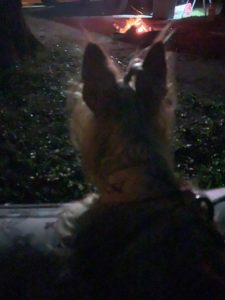
London waiting for the light rain to stop
Doggy Business. When it was time for bed, London had one more walk as we took turns holding her leash as we got ready for bed in the bathrooms. Be sure to always have poop bags with you, as your dog may not follow their usual potty routine. Even though you’re often walking in the “wilderness,” this is still no place to leave your dog’s poo behind. Sure, wild animals do it, but dogs are not part of the natural ecosystem in the woods. And with more people spending time outdoors with their dogs, there’s more dog waste. Unfortunately, it can cause harm to the environment; soil and water contamination from bacteria and the spread of parasites are reasons we should be picking up our dog’s business.
Wildlife Precautions. Back at camp, we made sure that the fire was out and that we had picked up any kibble London didn’t finish for dinner so that we didn’t attract unwanted raccoons and other wildlife. Some campgrounds, like Juniper Springs, ask that you keep any food, along with anything you used to cook with, in your car to avoid attracting bears. Also, take notice of warnings against bringing invasive species into the campgrounds and trails. These rules help protect Florida’s natural preserves.
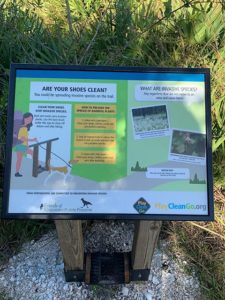
Be sure to leave invasive species behind!
Where Should My Dog Sleep?
Some people may want to keep the sleeping arrangements as similar as possible to those normally followed at home. This can help ease the anxious feelings of nervous dogs. London normally sleeps in a crate at night, but she would certainly prefer to sleep in bed with us. As this trip was all about having fun, we allowed her to sleep wherever she wanted inside the tent.
London started curled up on our daughter’s sleeping bag beside us, but as the temperatures started to fall, she hopped up on our air mattress. I could feel her shivering, so I tucked her into my sleeping bag and she soon warmed up. There is a bonding experience that happens when your pet seeks you out to fix what’s wrong and you’re able to provide that help.
As the dawn started to break and the birds started their calls, London popped her head out and started to “chuff,” which is sort of a whisper bark. She knew she wasn’t supposed to make noise, but boy did she want to! We got up for a walk and were rewarded with seeing wild turkey and deer. London was as impressed as we were!
We saw that another, much larger dog had spent his night on an elevated dog bed outside his owner’s tent. Some people bring their dog’s bedding and put it inside their tent, while some bring a crate to set up in their tent. If this is what you would like to do, make sure your tent is large enough to accommodate your dog’s sleeping arrangement.
Finally, always make sure your tent is fully zipped up if your dog is loose in the tent. This includes when leaving for, and coming back from, middle-of-the-night bathroom trips.
Adventures Await!
After breakfast, it was time to explore in the daylight. Back on the trail, we had walked the previous night, we could now see why we had heard so many baby alligators chirping. Even though the area looked like it was dry prairie land all around with just the smallest pond, there was still enough water in tiny streams that alligators could be seen on our walk. So definitely take care and don’t let your dog walk too near the sides of trails.
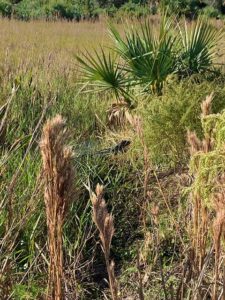
Beware of alligators!
On one of the very narrow trails, we were met by a couple walking two dogs that cautioned us to pick up London as they passed as their dogs were dog-aggressive. That is something you want to consider when bringing your dog camping. If your dog is aggressive towards other dogs or humans, staying at a campground may not be for them.
London’s short little legs tired out long before ours did, so it was good that the last trail we encountered didn’t allow dogs. She drank a surprising amount of water for her tiny size, so be sure to bring a little more water than you think you’ll need. Never let dogs drink from stagnant water sources like puddles or ponds. Plus, alligators.
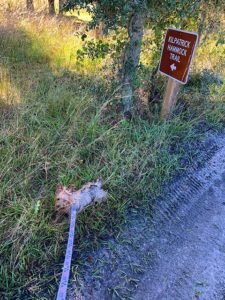
London takes a rest
All in all, London’s first camping trip was a huge success and we’ll be taking her again soon, as you could tell she enjoyed it as much as we did!
Some More Useful Tips
Grooming. While it may seem counterintuitive to have your dog groomed BEFORE a camping trip because you know you’re going to need to bathe them when you get home, getting long hair trimmed can help prevent them from picking an excessive amount of twigs, leaves, weeds, and burrs. Getting long nails trimmed can help prevent them from getting snagged. Bringing along a brush or comb is very useful for brushing out dirt and debris from longer coats.
Speaking of your dog needs a bath, bringing something to cover the seats in the car is also a great idea for the trip home.
First-Aid Kit. A human first aid kit is always good to have for a camping trip, but be sure to put one together for your dog too. You can purchase one, but make sure it includes:
- A pair of tweezers and a tick puller for any close encounters with nature
- Blood clotting powder in case of a ripped nail
- Gauze
- Stretchy bandages
- Scissors
A PACKING LIST:
Even though useful items have been mentioned throughout this blog, having a handy list is just much more convenient when packing. So here are the items mentioned, plus a few more. It’s a huge help to have all your dog’s gear in a separate bag, rather than mixed in with everything else.
- Food and bottled water, and don’t forget the treats!
- Bowls for food and water
- Toys, including chews
- Poop bags
- Printed, up-to-date vaccine records, or a screenshot of an electronic copy
- Flea, tick, and heartworm prevention
- Current photo of your pet, in case they get lost
- Leash, and collar or harness. Consider a reflective variety, so that you can see your dog more easily at night. A red light that clips to the collar for more visibility during nighttime activities is also handy.
- First-aid kit
- Usual medications your dog may take
- Tie-out stake
- Bedding
- Crate
- Towels
- Brush
- Sunscreen and bug repellent made especially for dogs. Never use products made for humans on pets.
We hope this post has given you some idea of what you can expect when you take your dog camping. If you take your dog with you on your next camping adventure, be sure to tag us on social media!
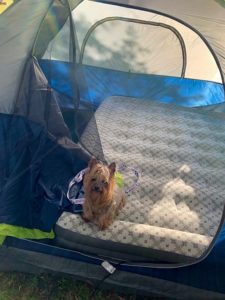
“Do we have to go home?”
